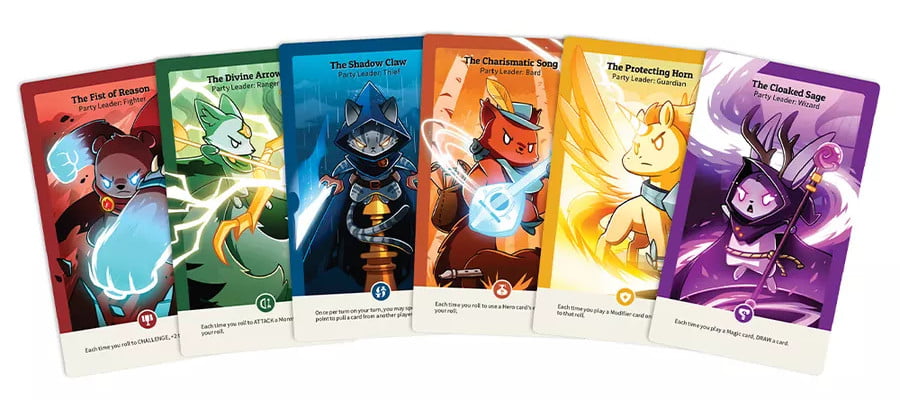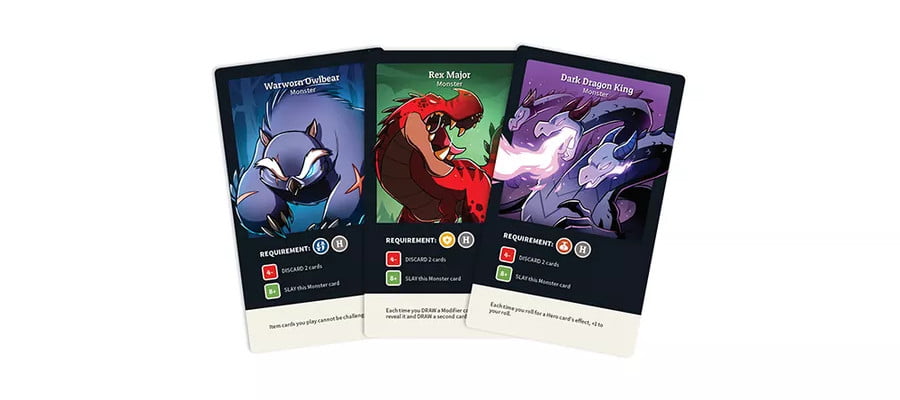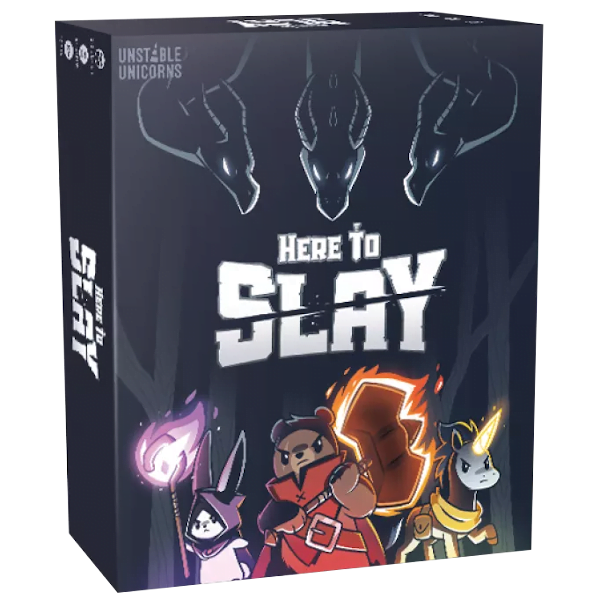Kickstarter has given rise to a particular genre of game which I think of as ‘crowdfundable.’ When you make games on kickstarter it’s very important to have an appealing hook that is communicated visually very distinctly; you simply need a sense of aesthetics to hold what you’re creating together. This means there’s a bunch of games on the market now, games that are pre-emptively successful, which are most notable for their aesthetics and the presence of important artists or setpiece gimmicks, that set precedent for a greater audience of designers to iterate on, and where the underlying game is maybe a bit deserving of a few more iterations of revision on the rules. Y’know, where just being good looking and being attached to an existing brand is enough to get units out the door so the actual game experience underneath it can be a bit ropy.
Oh hey, Here To Slay, what are you doing here?
In this game, you are competing to be the ones to defeat monsters, first or to gather a party of six different types. You can summon a hero into your party, can then do things, if they roll a dice, meaning that any given hero is kind of unreliable as they join your cause. Every hero can have an item equipped, but only one item. You can always goose dice rolls with ‘modifier’ cards that let you push your numbers up or down, and there are magical spells that represent single game actions to keep cards flowing around without dice rolls being involved. Finally, for any given hero, item, or magical spell, opponents can always play a Challenge, which gives you a slightly worse than 50/50 chance to get the thing you were doing.
You defeat the monsters by rolling dice to do the thing, and you need to fulfill a prerequisite to be able to roll those dice, like your party has to have a warrior or a druid or an actuary. If you successfully defeat a monster, you get a passive benefit that follows you around, which serves as an incentive to take out the big monsters even if you don’t want to do them as a means to win the game.
If you’re familiar with Magic: The Gathering or other complex strategy games you might appreciate the systems at work here; there’s layers of counterplay, with the Challenge cards representing an omnipresent ‘you could lose’ option, and modifiers to mess with dice rolls to try and make sure you can smooth out bad rolls.
The numbers and types all dovetail together quite nicely; in any given game, an ideal hand can go turn one, play three heroes, turn two, play two more heroes and immediately win the game, creating a vibe that imagines an ideal success that will almost certainly never happen.

I don’t like Here To Slay as a game, as a game designer. Not in a hilarious ‘oh wow, look at what a bad job these idiots did’ way, but rather just that the game is composed of competently constructed things that don’t quite connect. If a student handed in a game that played like this with prototype art, I’d want to point out some problems.
The first big complaint is fictional. Er, that is, the fiction of the game. It’s definitely built around the vibe of a dungeon adventure game, to the point that iconography, spell names, and monsters are all drawn whole cloth from classic Dungeons & Dragons stuff. The thing is, in those games, the game is fundamentally a narrative adventure about finding things, fighting harder things, getting better from the fighting, and triumphing over a boss monster. The monsters can also be defeated by a sequence of rolls, representing how big and difficult they are. Here, they’re a simplified single roll, and you’re competing with other people to be the first to do it. What’s even weirder is that one of the normal ways people debase the narrative of ‘go fight an avatar of evil’ stories, money, isn’t present. It’s not like there’s a reward for being the one who beats up the dragons.
The characters being unified by race and class also presents a problem here. One of the strongest things of D&D is the way that your dwarf warrior and an elf warrior can be unified by their warrior-ness and who they worry but different in how, because of who they are as warriors. It flattens things in the name of visual communication, and ties ‘class’ and ‘race’ together. I don’t like that.
It’s fussy and bitty as well in ways that don’t quite justify themselves. You can get a version with standees, which don’t communicate more information but do increase the table presence of what I’d normally see as a card game best recarded for how little table presence it demands. The dice mean that the play area needs a space for rolling which would normally be occupied by a discard and and draw deck. These are things that are kind of at odds with one another.
I don’t like the rolls at all but I can appreciate their purpose in the game’s systems: They’re there to make it so that the play outcomes are uncertain. You need that uncertainty, because if you didn’t have it, the game system could very easily collapse into non-games in one or two turns. Challenges stop the game from advancing, because advancing the game puts you close to winning, and stopping someone from winning forms the bulk of the endgame, where cards are held and people wait to see if they can do something to win in one turn… and then everyone holds their breath until someone else finally acts.

Fundamentally, what frustrates me the most about this game is the way this excellent aesthetic is layered on a game which feels like a very strong 7/10 design. Every part of the game’s visual representations is something someone had to work hard to make, and demonstrates a beautifully interconnected philosophical perspective. It’s got all these wonderful visual details about how characters have different sized bodies and shaped relationships to weapons and powers. The potions have different details about how they’re corked, and all the hero cards match in colour palette with their symbols, and their mechanics reflect their symbols as well. Simply put, there’s so much work put into this game aesthetically, that when those aesthetics rest atop a game whose systems are … just…
A bit wrong?
It’s a little despairing. This game looks good. I wish it was as good as it looks.

1 Comment
@updates @AmyZenunim If "Here to Slay" isn't a drag-themed game, then that's one tragic missed opportunity.